Brooklyn Bridge Table
You might say I’m a bit obsessed with the Brooklyn Bridge. I look for it in every commercial, film clip, news story, or social media photo or video set in NYC. And usually I am rewarded with at least a passing shot of it.
Why is it so special to me? Of course, I wrote a novel in which the bridge itself becomes a character, but that was the result of, rather than the cause of my obsession.
Growing up in northern New Jersey, NYC was our Oz. Huge, mysterious, a little dangerous, it was the ultimate destination for adventurous teens. I loved the hustle and bustle, the architecture, the food, the people watching.
I also love high places. My father liked to go to the “tippy top” of buildings, monuments, or the high hills/low mountains of our hometown. We walked across the George Washington Bridge, climbed the Statue of Liberty, rode the elevators to the top of the World Trade Center and the Empire State Building. But somehow we never walked across the Brooklyn Bridge, and Brooklyn was never a destination.
So when as an adult I admired the beauty of it, and noticed how much of an icon it was for the city, I began to research its origins. The story captivated me, especially Emily Warren Roebling’s part in it. Years of research and writing the story in several formats followed—first a theatrical play, a musical, a screenplay, and finally a novel that became The Engineer’s Wife. That whole process is a story unto itself, and here I want to write about a table.
After moving over 20 times for my husband’s career, we finally settled in our forever home in Florida. We never had a real dining room table, just a kitchen table that sometimes lived in a tiny “dining room” of government quarters if that was the only place for it.
So, in our new (to us) house, I wanted something special. I worked with Norman, a local woodworker, on several ideas. I loved “live edge” tables, but they were getting so common, and not quite the right look for my nearly 100 year-old home. I had an inspiration picture of a table fashioned from curvy wood and wire. I loved it because it reminded me of the Brooklyn Bridge, but it was too modern.
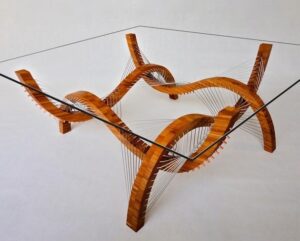
Norman was also excited about fashioning something from wood and wire, something unique and personal. A glass top would be perfect, in order to showcase the table base.
We sketched diagrams and traded ideas. We both wanted something to artistically represent the bridge, without being too literal.
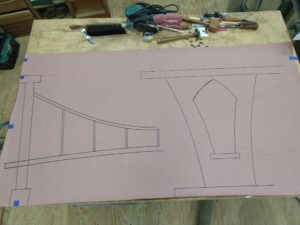
He even made a mock up out of styrofoam.
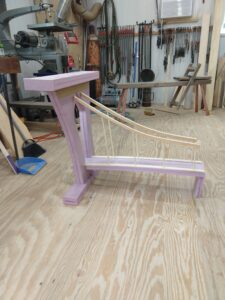
Agreeing on the design, we moved on to choosing wood. We wanted something with a beautiful grain, but sustainably sourced. Norman came upon these crotch wood pieces of guanacaste that seemed to be begging to used for the “towers”.
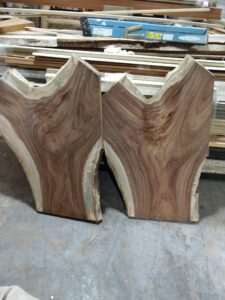
And the project was on. Soon Norman wrangled cables and stringers from metal.
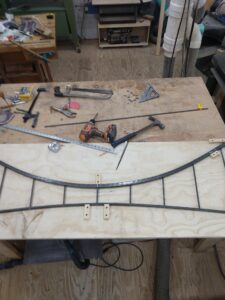
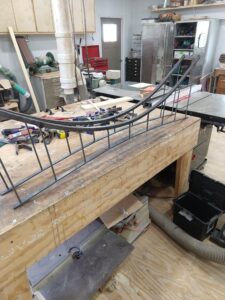
He fashioned a roadway of wood, and put it all together.
We choose a stain to coordinate with my antique china cabinet.
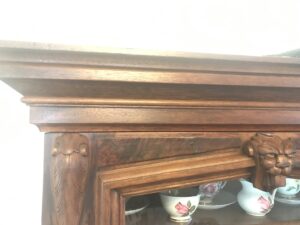
Norman contacted several glass suppliers who could fashion the top from beveled, tempered glass.
And finally, she was finished.
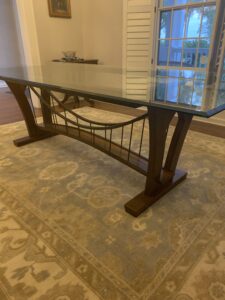
All I needed to do was find some chairs that would allow her to shine.
But something seemed to be missing. Jumbo the Elephant. I just happened to have the perfect carved elephant that my husband had brought back from Africa.
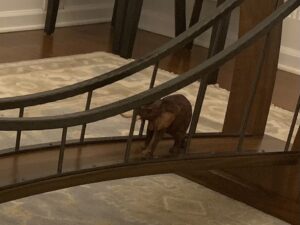
Now, she’s the centerpiece of our home, and I proudly show her off to all visitors. And if they don’t know why there’s an elephant on the roadway, they are sent packing. Just kidding, they just get a short history lesson and shameless plug for my book. 🙂
Tracey Enerson Wood
January, 2024
Lessons From My Dog
My puppy dog, Violet, taught me something today. She was spayed and had other minor surgery yesterday, so of course she’s not feeling great and has to wear a huge, uncomfortable donut around her neck.
I should add that she is the fussiest dog ever when it comes to anything on her except for a standard collar, and has a hissy fit if we try to use even the smallest, softest harness. She is a brave girl, afraid of nothing, yet hypersensitive to even the smallest owie. I should also add that she is the smartest dog I have ever met, and seems to understand nearly everything I say to her, even while deciding which of my instructions she feels like obeying.
While I was trying to make her as comfortable as I could, she looked up at me with the most forlorn expression. She seemed to be asking why I put the horrible collar on her, and why wouldn’t I take it off. Why did I take her to that place that hurt her, when we loved each other so much? She seemed to be saying, I love you and trust you, but you let me down so very much.
Her look just melted my heart. I wanted to explain that the surgery was for her own good. It would prevent her from the painful and exhausting work of having puppies, of the harassment of male dogs when she is in season. It will help prevent cancer and other diseases, and give her, and us a better quality of life.
But of course none of this was within her ability to comprehend, even with her high intelligence for a dog. She had no choice but to trust me, and know I loved her and was trying to make things better.
And this is when her lesson hit me. I thought about God, a superior being, who does things that are right for us, but we have no way of understanding. Awful things, like taking away a beloved child, or allowing the best and brightest of us to suffer a terrible disease.
“Why?” we always ask. We can tell ourselves that everyone and everything must pass, in order to make room for the new. Sometimes there must be suffering, so that we can learn to make changes to make things better for others. Maybe God thinks it’s better for parents to have a few precious years with their angels, than none at all, as there’s only room for so many angels on this earth.
But the lesson my precious Violet was teaching me is that we can’t possibly understand. We are human, and these things are simply outside our comprehension. We must trust God, or whatever universal power we believe in, that things happen for an unknowable reason, that He loves us and things are the way they must be.
We must cope the best we can, love and help others to cope as well. We must learn if there is a lesson to be learned, make changes if they are called for, and survive if we simply need to survive.
While I don’t believe in throwing up our hands and “leaving it up to God” when things get tough – it is our duty to do all of which we are humanly capable. After that, we must have faith.
Putting the “Fiction” in Historical Fiction
I’m often asked where I get ideas for my books. And the answer is never a quick one.
Since my novels center on real women in history, who did amazing, yet unrecognized things, finding them is a matter of researching until I find the most inspiring and interesting persons, whose stories just demand to be told.
But as it is fiction, I get to make up the details of the story that are lost to history. The setting, the dialog, the emotions, all have to be created in a way that draws the reader in, and makes sense for the characters and plot.
Sometimes, I enjoy imagining a place I’ve never been. Do I smell smoke from a distant forest fire, or hear the drumbeats of a tribal dance? Does the raw wind chafe my cheeks, or is it damp and warm as a dish sponge? Do I hear raucous laughter from patrons tumbling out of a pub, or waves tinkling against an icy shore?
Documentaries such as Netflix’s Night on Earth are very helpful for sight and sounds of places I’ve never been, and a trip to a specialty food store can provide a wealth input for the other senses.
Usually, scenes are developed from a combination of my own experiences, and ones I imagine. I choose scenes from my own life when there is something memorable about them, that is somehow connected to my characters’ experience, especially in a very emotional, or sensory way.
For example, in The War Nurse, Julia receives a gift of fragrant white lilacs. As she muses about why they are special to her, she reveals that as a child, she had the honor of placing a crown of lilacs on a statue of Mary, Mother of Jesus. This stemmed from my own childhood experience at a Catholic school ceremony that had forever imprinted in me the powerful fragrance, as well as how it felt to be suddenly thrust in the spotlight.
Another example occurs in The Engineer’s Wife in a very emotional scene between Wash and Emily. They have reached a critical point in their marriage, and Wash needs to give Emily some rather disturbing news. I chose to set the scene in a fairly mundane place. This would help to ground the reader, so that they could focus on the emotional development of the characters. In this scene, Wash and Emily share an impromptu before-dawn breakfast.
Wash cooks Taylor Ham, a meat product that is both historically accurate for the time period and their location, and is still a beloved local favorite enjoyed by and hotly debated by many, like me, who grew up and/or live in the NY/NJ/Eastern PA area. In addition to providing my characters something superficial to talk about while they’re getting to the real conflict, putting the ham in the story was a little wink to my fellow Tri-staters, and our nostalgia for its special foods and traditions.
As I research historical women in order to settle on my next heroine, I think about the environment she lived in. Do I have something in my own life experience that will add to the depth of the world I will build for her? Did our paths cross, merely separated by time? Perhaps they lost a loved one in a way that I can empathize with, or faced a physical or emotional challenge to which I can relate.
Adding in personally experienced details does not replace the creativity of imagined ones. They add depth and a sense of reality that enriches the reader’s experience.
Copyright 2021 Tracey Enerson Wood